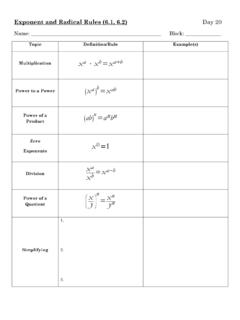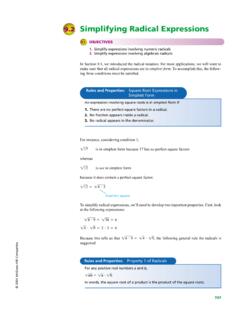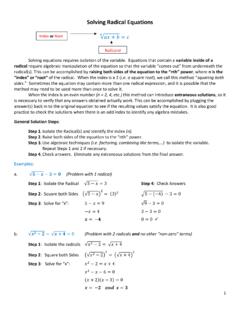Transcription of Algebra II - Virginia Department of Education
1 Mathematics Standards of Learning for Virginia Public Schools September 2016 1 Algebra II Students enrolled in Algebra II are assumed to have mastered those concepts outlined in the Algebra I standards. A thorough treatment of advanced algebraic concepts will be provided through the study of functions, equations, inequalities, systems of equations, polynomials, rational and radical equations, complex numbers, and sequences and series. Emphasis will be placed on practical applications and modeling throughout the course of study. Oral and written communication concerning the language of Algebra , logic of procedures, and interpretation of results should also permeate the course. These standards include a transformational approach to graphing functions. Transformational graphing uses translation, reflection, dilation, and rotation to generate a family of functions from a given parent function and builds a strong connection between algebraic and graphic representations of functions.
2 Students will vary the coefficients and constants of an equation, observe the changes in the graph of the equation, and make generalizations that can be applied to many graphs. Graphing utilities (calculators, computers, and other technology tools) will be used to assist in teaching and learning. Graphing utilities facilitate visualizing, analyzing, and understanding algebraic and statistical behaviors and provide a powerful tool for solving and verifying solutions. Expressions and Operations The student will a) add, subtract, multiply, divide, and simplify rational algebraic expressions; b) add, subtract, multiply, divide, and simplify radical expressions containing rational numbers and variables, and expressions containing rational exponents; and c) factor polynomials completely in one or two variables. The student will perform operations on complex numbers and express the results in simplest form using patterns of the powers of i.
3 Equations and Inequalities The student will solve a) absolute value linear equations and inequalities; b) quadratic equations over the set of complex numbers; c) equations containing rational algebraic expressions; and d) equations containing radical expressions. The student will solve systems of linear-quadratic and quadratic-quadratic equations, algebraically and graphically. Functions The student will investigate and apply the properties of arithmetic and geometric sequences and series to solve practical problems, including writing the first n terms, determining the nth term, and evaluating summation formulas. Notation will include and an. Mathematics Standards of Learning for Virginia Public Schools September 2016 2 For absolute value, square root, cube root, rational , polynomial, exponential, and logarithmic functions, the student will a) recognize the general shape of function families; and b) use knowledge of transformations to convert between equations and the corresponding graphs of functions.
4 The student will investigate and analyze linear, quadratic, absolute value, square root, cube root, rational , polynomial, exponential, and logarithmic function families algebraically and graphically. Key concepts include a) domain, range, and continuity; b) intervals in which a function is increasing or decreasing; c) extrema; d) zeros; e) intercepts; f) values of a function for elements in its domain; g) connections between and among multiple representations of functions using verbal descriptions, tables, equations, and graphs; h) end behavior; i) vertical and horizontal asymptotes; j) inverse of a function; and k) composition of functions algebraically and graphically. The student will investigate and describe the relationships among solutions of an equation, zeros of a function, x-intercepts of a graph, and factors of a polynomial expression. Statistics The student will collect and analyze data, determine the equation of the curve of best fit in order to make predictions, and solve practical problems, using mathematical models of quadratic and exponential functions.
5 The student will represent and solve problems, including practical problems, involving inverse variation, joint variation, and a combination of direct and inverse variations. The student will a) identify and describe properties of a normal distribution; b) interpret and compare z-scores for normally distributed data; and c) apply properties of normal distributions to determine probabilities associated with areas under the standard normal curve. The student will compute and distinguish between permutations and combinations.

















